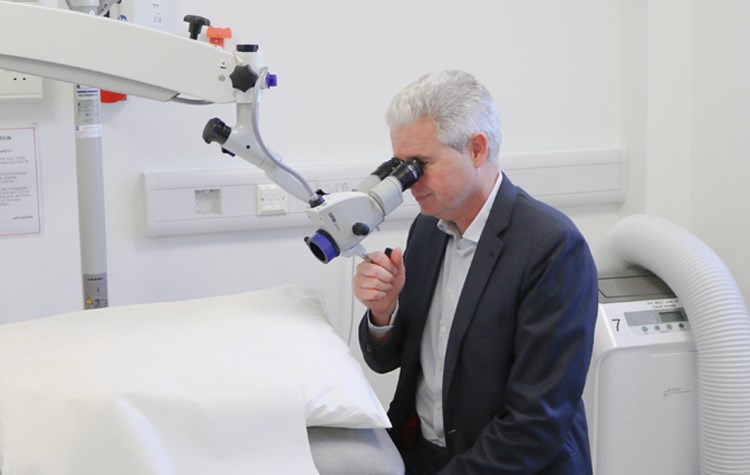Have you got blocked, itchy, painful, or aching ears? You could have ear wax build-up. Our Consultant ENT Surgeon, Mr Henry Sharp, has put together a helpful guide to ear wax removal and how our microsuction treatment is the safest, most effective way to alleviate your ear canal symptoms.
What is ear wax removal?
Ear wax is produced by glands in the ear canal skin that forms a protective barrier against bacteria and microbes entering the ear canal. It is a myth that earwax is dirty and unhealthy when it’s quite the opposite. It’s important to know that normally you don’t have to remove earwax as your ear is designed to be self-cleansing through a process called epithelial migration. During this wax is gently moved from your ear canal to the opening of your ear.
Various factors can prevent this process from happening properly and wax may become stuck or impacted in the ear canal. It is at this point, when patients will become aware of something feeling not quite right and will want to consider booking an appointment at our private ENT service.
What are the symptoms of ear wax build-up?
If you’re struggling with any of the below symptoms, you may have ear wax build up and it’s important to speak to a healthcare professional. If left untreated, it can lead to deafness, pain, infection and coughing (the wax can stimulate a nerve that’s linked to the voice box).
- Vertigo – feeling sick or dizzy
- Tinnitus – ringing or buzzing in your ears
- Hearing loss
- Earache
- Sensation that your ears are blocked or feel full
- Itchy ears
- Odor or discharge in the ear
- Pain in your ear
Who is likely to develop a build-up of ear wax?
Sometimes people are predisposed to earwax build-up due to genetics and the way the ear is shaped. For example, people with very hairy ear canals are more likely to get problems, as are those with narrow or damaged ear canals and those that wear a hearing aid mould in the ear. People who have had ear surgery such as mastoidectomy will usually have to have their ears cleaned out on a regular basis due to the surgical formation of a cavity within the ear that cannot clean itself.
If have a skin condition that affects your scalp or around your ear, or if you have inflammation of your ear canal due to “Swimmer’s Ear”, your ear canal may not be able to clean the wax out of your ear.
Some peoples wax is of a more liquid consistency and therefore will not come out of the canal either.
Is microsuction safe?
Ear wax removal by microsuction is the safest and easiest way to remove ear wax from the outer ear, including for anyone with a perforated eardrum (hole in eardrum) or for someone with grommets. Many of my patient’s also report feeling comfortable and pain-free during their microsuction. You’ll probably only hear some clicking, popping or a suction sound.
Whereas ear syringing and irrigation flood the ear with water, this procedure keeps your ear canal dry which reduces the risk of developing an infection. No prep is needed, such as using ear drops to soften the wax, before this procedure.
During this five-to-ten-minute procedure, I use a microscope to look into your ear canal which gives me a clearer view of where the wax is building up. I then insert a tiny suction tube into the canal and suction any ear wax blockage from the area. This makes the procedure more efficient and less invasive.
What ear wax removal methods should you avoid?
Cotton buds
Don’t use cotton buds to clean your ears! They do far more harm than good as this can result in pushing the ear wax further inside your ear, scraping the ear canal skin, causing pain, bleeding or even infection. There’s a saying we should all follow – don’t put anything smaller than your elbows inside your ears!
Ear Candling
I don’t recommend ear candling which involves putting a lighted candle very near your ear! Especially if you were doing this on yourself, you could be at serious risk of burning your ear or hair. Ear candles are often hollow fabric cones soaked in wax or paraffin and people cut a hole in a paper plate and stick the candle into it to ensure candle wax or ash doesn’t fall.
The candle is then placed in the ear canal and it burns for 15 minutes. Some report that it creates a low suction force that draws the wax and debris from their ear. However, this has not been clinically proven.
What are some other ear wax removal methods?
Ear drops
There are plenty of over-the-counter wax softening drops which you can buy such as Sodium Bicarbonate or Otex, which contains Hydrogen Peroxide which fizzes inside the ear to help loosen the wax. In many cases this will allow the wax to come out naturally, but sometimes like all these blind procedures may itself cause infection around the wax. In general, I am not a fan of Olive Oil in this situation, as I think it tends to cause a rather greasy unhealthy mess around and inside the ear.
Ear syringing
If ear drops don’t work, ear syringing can be performed by your GP, whereby a pressure of water is gently syringed into the ear and by the jet of water getting behind the wax is able to push it out. This is, however, another blind process which in some cases is not successful and can also cause pain and infection due to the water being pushed into the ear. For this reason, microsuction is the best choice for ear wax removal.
Private ear wax removal
Myself and our experienced Ear Nose and Throat (ENT) Consultants offer a wide range of treatments for a range of common conditions. Our ENT service provides the latest treatments and modern diagnostic facilities to help you feel better again.
Many patients choose our private hospital for their ear wax removal so they can get treated in a discreet environment as our hospital is located in the Kent countryside.
To find out more about ear canal microscution or other ENT treatments, or to book an appointment, complete our online booking form or contact our Private Patient team via LiveChat or on 01580 363158.
Published on 20 May 2024







